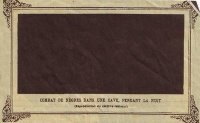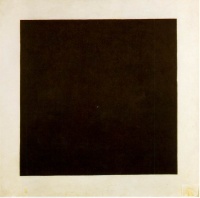Monochrome
From The Art and Popular Culture Encyclopedia
(Difference between revisions)
| Revision as of 19:47, 17 June 2013 Jahsonic (Talk | contribs) ← Previous diff |
Revision as of 19:24, 10 April 2014 Jahsonic (Talk | contribs) Next diff → |
||
| Line 1: | Line 1: | ||
| - | [[Image:Black Square by Malevich.jpg|thumb|right|200px|''[[Black Square]]'' (1915) by [[Kazimir Malevich]]]] | + | [[Image:Black Square by Malevich.jpg|thumb|left|200px|''[[Black Square]]'' (1915) by [[Kazimir Malevich]]]] |
| + | [[Image:Combat de nègres dans un tunnel.jpg|thumb|right|200px|''[[Negroes Fighting in a Tunnel at Night]]'' (1882) by [[Paul Bilhaud]], here shown in the 1887 version [[appropriation|appropriate]]d by [[Alphonse Allais]] as published in ''[[Album primo-avrilesque]]'' (April fool-ish Album)]] | ||
| {{Template}} | {{Template}} | ||
| :''[[monochrome painting]]'' | :''[[monochrome painting]]'' | ||
Revision as of 19:24, 10 April 2014

Negroes Fighting in a Tunnel at Night (1882) by Paul Bilhaud, here shown in the 1887 version appropriated by Alphonse Allais as published in Album primo-avrilesque (April fool-ish Album)
|
Related e |
|
Featured: |
Monochrome comes from the two Greek words mono (μoνο, meaning "only" or "alone"), and chroma (χρωμα, meaning "color"). A monochromatic object has a single color.
See also
- Duotone – the use of two ink colors in printing
- Halftone – the use of black and white in a pattern that is perceived as shades of grey (may be extended also to color images)
- Polychrome – of multiple colors, the opposite of monochrome
- Monochromacy (color blindness)
- Selective color – use of monochrome and color selectively within an image
- Monochrome painting – monochromes in art
Examples outside of art
Unless indicated otherwise, the text in this article is either based on Wikipedia article "Monochrome" or another language Wikipedia page thereof used under the terms of the GNU Free Documentation License; or on research by Jahsonic and friends. See Art and Popular Culture's copyright notice.


